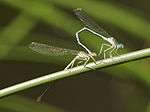White-legged damselfly
| White-legged damselfly | |
|---|---|
_male.jpg) | |
| Male | |
_female.jpg) | |
| female both in Warsaw, Poland | |
| Scientific classification | |
| Kingdom: | Animalia |
| Phylum: | Arthropoda |
| Class: | Insecta |
| Order: | Odonata |
| Suborder: | Zygoptera |
| Family: | Platycnemididae |
| Genus: | Platycnemis |
| Species: | P. pennipes |
| Binomial name | |
| Platycnemis pennipes (Pallas, 1771) | |
The white-legged damselfly or blue featherleg (Platycnemis pennipes) is a damselfly of slow-flowing, muddy waters.[1] It occurs from the Atlantic to Siberia and is often abundant throughout its range.[2]
Morphology
Platycnemis pennipes is about 32 millimetres (1.3 in) long.[3] Mature adults differ from most other blue damselflies in having expanded white edges to the tibiae, paired black markings down most of the abdomen, broad pale brown double antehumeral stripes, wider head and a pale brown pterostigmata.[1]
The male has a blue abdomen that is often pale and usually has a greenish thorax. The female is a very pale yellow-green colour with black markings.
_immature_male.jpg)
_immature_female.jpg)

- detail of male head
Breeding

This species favours unshaded slow-flowing sections of muddy rivers with abundant floating vegetation. it has been recorded in tidal rivers and the larvae seem well able to tolerate brackish water. It also occurs in muddy streams but is rare in lakes or ponds of any sort.[1] In north-west Europe, it is mostly confined to flowing waters.[2]
Mating is preceded by the male displaying his white legs in a fluttering display flight in front of females.[3] Elongated eggs are laid whilst in tandem, into emergent stems and especially the underside of floating leaves. The larvae live amongst bottom debris and emerge after two years.
Behaviour
_-2013-06-03.webm.jpg)
After emerging, adults tend to congregate in the shelter of tall vegetation, although some immatures wander away from water and have been found five kilometres away from the nearest breeding site.
References
- 1 2 3 Dijkstra; Lewington. Field Guide to Dragonflies of Britain and Europe. ISBN 0-9531399-4-8.
- 1 2 Clausnitzer, V. (2007). "Platycnemis pennipes". IUCN Red List of Threatened Species. Version 2010.3. International Union for Conservation of Nature. Retrieved 14 October 2010.
- 1 2 "Platycnemis pennipes". British Dragonfly Society. Retrieved 28 May 2011.
External links
 Media related to Platycnemis pennipes at Wikimedia Commons
Media related to Platycnemis pennipes at Wikimedia Commons Data related to Platycnemis pennipes at Wikispecies
Data related to Platycnemis pennipes at Wikispecies
